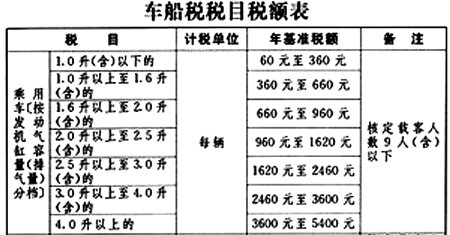Taxes for Taxes and Taxes Following the introduction of the draft in October 2010, the trend of the adjustment of the tax laws for vehicles and boats has attracted much attention. On February 25th, 2011, the new tax law for vehicles and ships finally settled. The Ninth Session of the 11th National People's Congress passed the new tax law for vehicles and ships. The tax standards for passenger vehicles are divided into seven categories according to the volume of exhaust gas. The base tax will be from 60 to 360 yuan below 1.0 liters and from 3,600 to 5,400 yuan above 4.0 liters. It is reported that the new vehicle and boat tax law will be implemented from January 1, 2012. Compared with the previous draft, the new vehicle and boat tax law takes into account the resilience of most vehicle owners. The highest annual levy 5,400 yuan According to the Taxation Law for Vehicles and Vehicles, the taxation of passenger and passenger vehicles and boats is divided into 7 grades according to the displacement. The annual tax base for passenger car and boat tax will be from 60 to 360 yuan, which is less than 1.0 liters, to 3,600 yuan to 5,400 yuan, which is more than 4.0 liters, and the maximum gap will reach 90 times. With regard to vehicles and boats such as energy-saving and new energy, the newly passed tax laws for vehicles and boats clearly stipulate that the taxes on vehicles and boats may be reduced or exempted. If it is necessary to reduce or exempt taxes due to the difficulty of paying taxes due to the impact of severe natural disasters and other special reasons, it may be possible to reduce or exempt the taxes on vehicles and boats. The specific measures shall be prescribed by the State Council and reported to the Standing Committee of the National People's Congress for the record. The tax laws for vehicles and boats stipulate that the specific applicable tax for vehicles shall be determined by the people’s governments of provinces, autonomous regions and municipalities directly under the Central Government in accordance with the amount of taxation stipulated in this Law and the provisions of the State Council. The travel tax law will come into effect on January 1, 2012. The Provisional Regulations on Vehicle Taxes announced on December 29, 2006 was repealed at the same time. The draft reduced the standard Judging from the new tax laws and regulations introduced this time, the standards for the collection of passenger cars below 2.0 liters are very different from those in the draft. The government took more considerations into the affordability of most car owners and made them more human. It is reported that in the collection of opinions in October last year, the levy in the tax on vehicles and ships was 60 to 360 yuan below 1.0 liters; 1.0 to 1.6 liters was 360 to 660 yuan; 1.6 to 2.0 liters was 660 to 960 yuan. Many of these opinions indicate that passenger cars with a displacement of less than 2.0 liters are the main models owned by the average consumer. The draft should not raise the taxation of such vehicles and demand to reduce or maintain the current tax. However, in the new tax law on vehicles and boats, the reporter noted that the standards for the collection of vehicles under 2.0 liters have basically maintained the current tax amount or have slightly decreased, but the vehicle tax amount above 2.0 liters has increased. It is reported that at present, passenger cars of 2.0 liters or less account for about 87% of the total number of passenger vehicles in China. Relevant experts said that the new vehicle and boat tax collection standards will not increase the tax burden on most vehicle owners. Change the "one size fits all" situation According to the reporter’s understanding, the current standards for the collection of vehicle and boat taxes are based on the number of seats and the size of the vehicles. Small cars under 9 seats (including private cars) are required to pay 360 yuan, 20 seats and 20 seats per year. Each of the above-mentioned large-size buses pays 480 yuan for each vehicle each year, and medium-sized passenger buses of 10 to 19 seats each pay 420 yuan per vehicle per year. Under the current current standards, regardless of whether you are driving a 1.0-liter Chery QQ or a 4.0-liter Mercedes-Benz or BMW, the tax paid every year is 360 yuan. Jacquard Fabric,Jacquard Knit Fabric,Cotton Jacquard Fabric,Polyester Jacquard Fabric SHAOXING BAOYING TEXTILE CO.,LTD , https://www.baoyingfabric.com
The new tax law will change the current "one size fits all" taxation method. “At the same time as reducing the tax on small-displacement vehicles, the new draft on vehicle and boat tax shows heavy blows on large-displacement vehicles.†Industry insiders believe that the new tax laws on vehicles and boats appear to be more equitable. In the future, the automobile consumption structure will be affected more or less. Large-displacement, small-displacement heat consumption at both ends of the "dumb-bell" pattern will be more apparent.